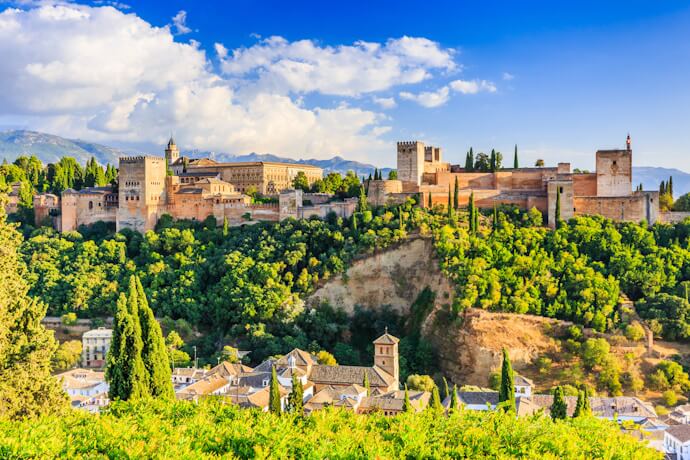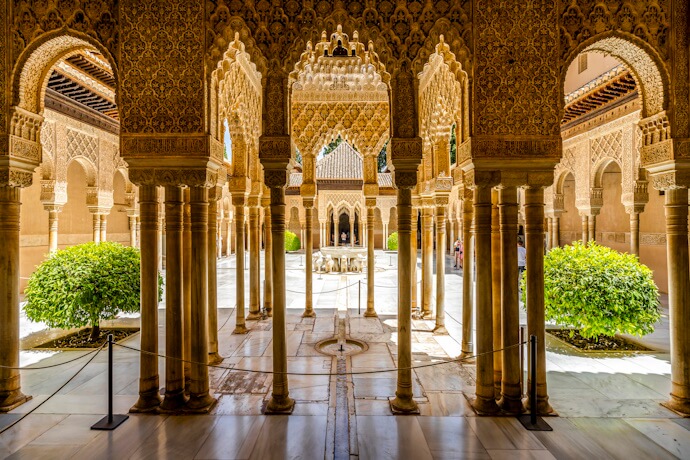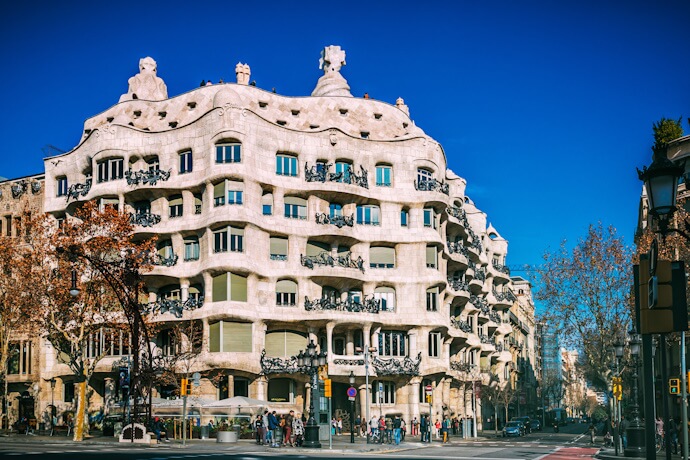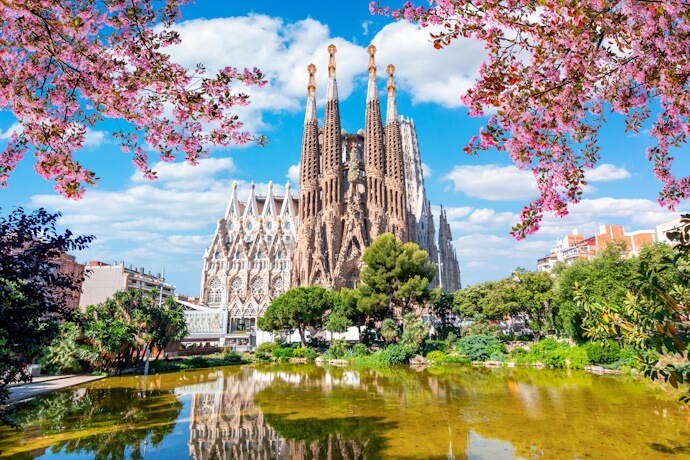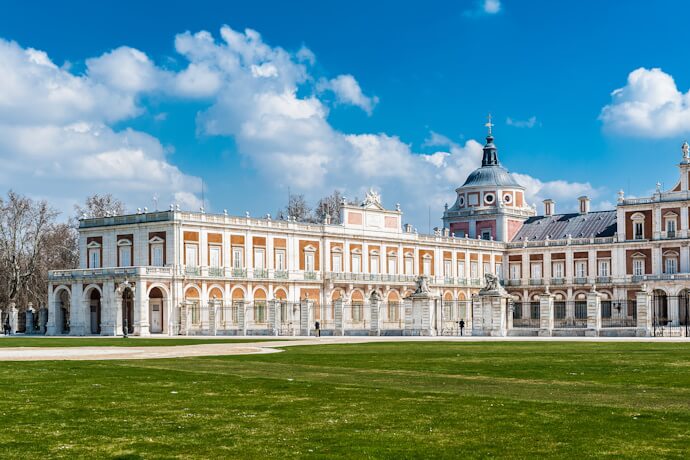Get ready for a trip that invites you to explore the heart and soul of Spain through its UNESCO World Heritage Sites!
This nation, a proud custodian of a lavish fabric of cultural triumphs and natural beauty, stands among the elite trio of countries celebrated for their unparalleled contribution to the UNESCO heritage pantheon.
In this article, we endeavor to chart a route less ordinary, guiding you through a selection of Spain's UNESCO marvels. While it is a herculean task to distill the essence of Spain's vast heritage into a mere article, we aim to rank these sites by more than their splendour— for each holds an intrinsic, incomparable value— but by weaving a route that promises to enchant, educate, and inspire! It is an invitation to tread lightly on sacred grounds that have witnessed millennia unfold.
Join us as we embark on this voyage across Spain, where each step uncovers a story, each site a world unto itself. Are you ready to venture beyond the ordinary?
Alhambra
Perched atop the rolling hills of Granada, the Alhambra serves as a profound homage to the poetic soul of Spain. It is a majestic fortress complex from 889 AD that weaves together the delicate threads of history, art and nature into a breath-taking tapestry.
The Alhambra's past mirrors the complex history of Spain itself, marked by conquests, cultural exchanges, and the coalescence of diverse civilizations. Originally constructed as a small fortress in 889 AD on the remnants of Roman fortifications, it was rebuilt in the mid-13th century by the Nasrid emir Mohammed ben Al-Ahmar of the Emirate of Granada. It was this transformation that began the Alhambra's evolution into a magnificent royal palace.
The Alhambra is a symphony in stone. Its design is a harmonious blend of light, water, wood, plaster, and stone, meticulously crafted to reflect the paradisiacal ideals of Islamic art. The complex includes the Nasrid Palaces, renowned for their stunning stucco work, intricate wood carvings, and intricate tile mosaics, which create a visual and architectural narrative that speaks of a golden age of creativity and intellectual flourishing.
This monument enjoys the distinguished status of a UNESCO World Heritage Site, a recognition that underscores its global significance and the universal value of its artistic and architectural achievements.
Works of Antoni Gaudí
The works of Antoni Gaudí are a manifesto of imagination, a dreamscape carved into the very fabric of Barcelona’s urban landscape. Each of the seven UNESCO-recognized creations by Gaudí is proof of his visionary genius.
Parque Güell in Barcelona is a fantastical garden city that unfolds like a page from a fairy tale, with serpentine benches, whimsical sculptures, and mosaic-adorned structures. It is a vivid, colourful world where the boundary between nature and architecture dissolves. Palacio Güell stands as a regal testament to Gaudí’s innovative vision, nestled within the winding alleys of Barcelona’s Raval district.
Gaudí’s work on the Nativity façade and Crypt of La Sagrada Familia reveals a divine spectacle, a basilica that reaches towards the heavens with its spires, while the Nativity façade tells the story of Christ’s birth through stone, a narrative sculpted with a depth of emotion and detail that invites contemplation and awe. Beneath this part of the monument, lies the Crypt, where Gaudí himself is laid to rest. The basilica's ongoing construction, a century after Gaudí's death, continues to be a testament to his vision, a project that transcends the life of its creator.
Casa Batlló, with its fluid lines, skeletal balconies, and scaly façade, evokes the legend of Saint George and the dragon. Gaudí transformed a conventional building into a stunning visual allegory, replete with symbolism. It is easy to understand why Casa Batlló is often referred to as the "House of Bones", thanks to its skeletal organic quality. The façade itself is a riot of colour and form, adorned with a mosaic of broken ceramic tiles.
Aranjuez Palace
Nestled in the lush embrace of the Tagus River's fertile plains, the Royal Palace of Aranjuez emerges as a masterpiece of design and diplomacy. This regal estate is a place where the Renaissance whispers to the Baroque, and nature itself is invited to the royal court.
A mere stone's throw from the bustling city of Madrid, Aranjuez offers a tranquil retreat, making it an ideal daytrip from Madrid. The Royal Palace itself is an architectural marvel, showcasing a stunning amalgamation of design principles from different epochs. Its façade, a spectacle of elegance and symmetry, invites the eye to linger over its intricate details, while the interior is a labyrinth of lavish decor, exquisite frescoes and sumptuous furnishings.
The site's gardens are equally majestic. The Jardín del Príncipe, with its delicate arrangements and exotic species, serves as a living museum of botany, while the Jardín de la Isla offers a serene oasis marked by meticulously designed landscapes.
Torcal de Antequera
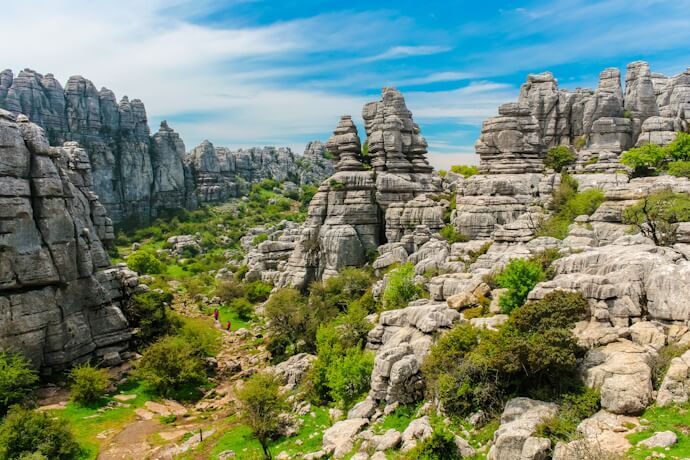
In the heart of Andalusia, amidst the rolling landscapes, lies the Torcal de Antequera, a natural cathedral sculpted by the hands of time itself. This primordial garden is renowned for its extraordinary karst formations.
Torcal de Antequera dates back million years, beneath the sea, where layers of sedimentary rock were thrust upwards by the relentless forces of geology. Over time, wind and water worked their alchemy upon these limestone canvases, carving them into fantastical shapes and towers. This natural labyrinth creates a landscape so unique, recognized by UNESCO.
The magic of Torcal de Antequera extends beyond its geological wonders. Neolithic tribes left their presence etched into the megalithic tombs that mark the landscape. These archaeological treasures add layers of mystery and humanity to the Torcal's natural splendour. You can follow the trails that lead through the heart of the park.
Segóvia Aqueduct
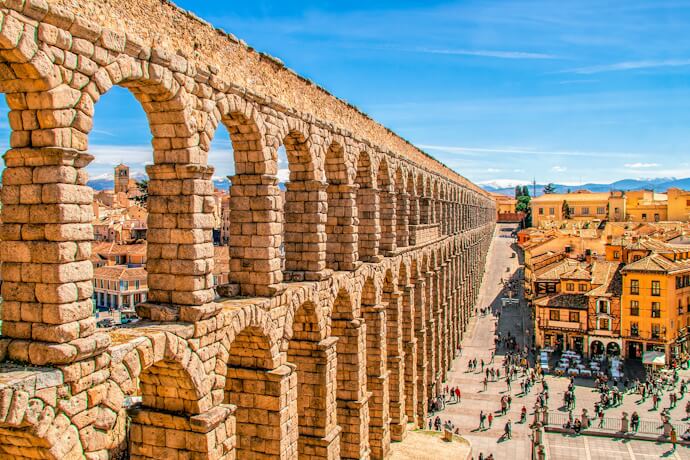
Rising from the heart of Segovia, the Segovia Aqueduct is an enduring and monumental marvel of ancient engineering that stretches like a stone serpent across the landscape. This colossal structure, built to quench the thirst of a city, has weathered the passage of millennia. It makes for a perfect day trip from Madrid, given its proximity to the capital.
Constructed around the 1st or early 2nd century AD, the aqueduct's precise origins are shrouded in the mists of time, yet its purpose was clear: to transport water from the Frío River, over 15 km away, to the burgeoning city of Segovia. Crafted from massive granite blocks, the aqueduct represents a pinnacle of Roman engineering.
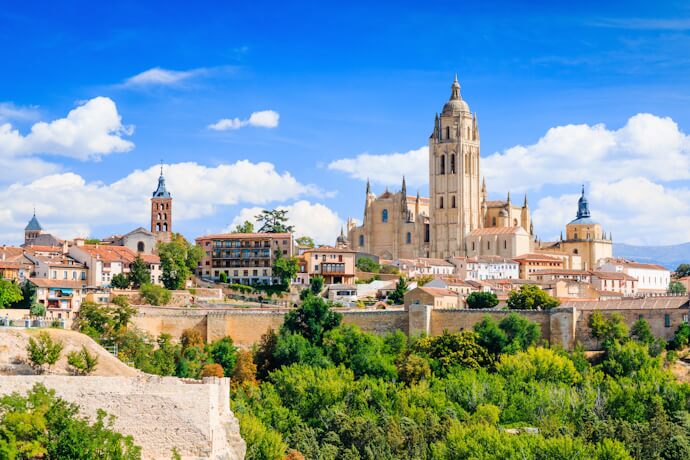
Its endurance through centuries speaks to the quality of its construction and the timeless nature of its design. It has become a UNESCO World Heritage Site, recognized for its outstanding value to humanity, a monument that transcends its utilitarian origins to become a symbol of human capability and creativity. The sight of this ancient edifice is nothing short of awe-inspiring.
Segovia is indeed a mosaic of medieval charm, Roman engineering marvels, and Renaissance elegance. Its ancient streets whisper tales of knights, kings, and the seamless blend of Christian, Muslim, and Jewish heritage, anchored by the iconic Segovia Aqueduct, the fairy-tale Alcázar, and the resplendent Segovia Cathedral.
Burgos Cathedral
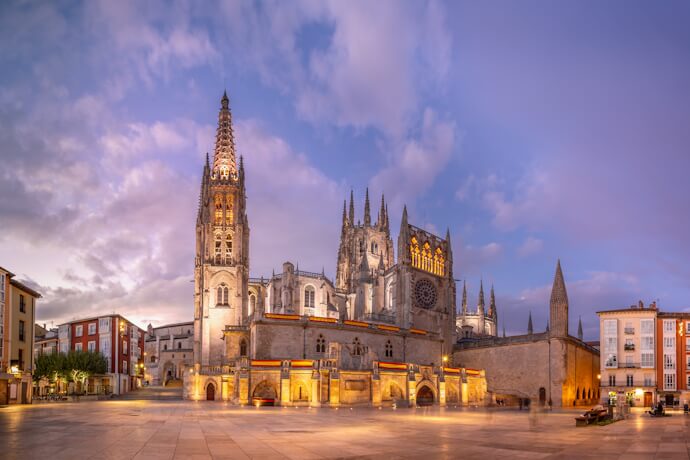
This masterpiece of Gothic architecture rises majestically above the historic heart of Burgos. Consecrated in 1260, this architectural marvel was envisioned as a symbol of the power and glory of God.
As one approaches the cathedral, its soaring spires and intricate façades unfold like a celestial vision. The exterior, adorned with an exquisite array of sculptures, gargoyles, and flying buttresses, is a grand overture to the magnificence that lies within. The main façade, known as the Puerta del Perdón, invites pilgrims and visitors into a realm of transcendent beauty.
The interior is a forest of stone, where columns rise to meet ribbed vaults, creating a space that is both awe-inspiring and intimate. Each chapel, each altar, is a repository of art and history, from the elaborate star-shaped dome of the Capilla del Condestable to the solemn beauty of the tomb of El Cid and his wife, Doña Jimena.
In 1984, UNESCO recognized the Burgos Cathedral as a World Heritage Site, affirming its significance as a monument of cultural and historical importance in Spain and around the globe.
La Lonja de la Seda, Valencia
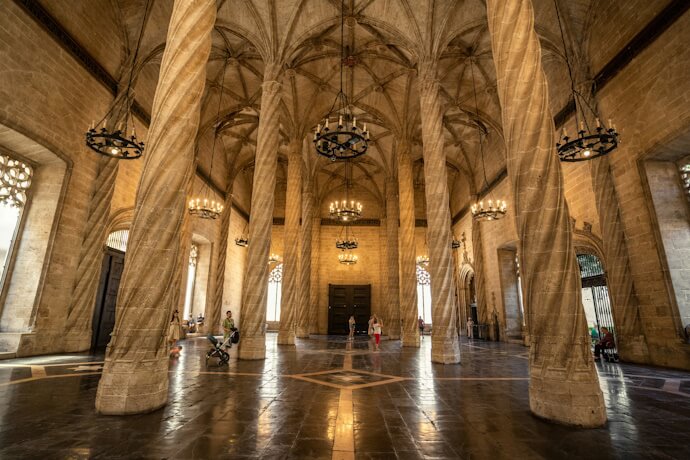
La Lonja de la Seda, or the Silk Exchange, in the heart of Valencia, is a symphony in stone, a Gothic masterpiece that narrates the story of commerce, art, and society in medieval Spain. Constructed between 1482 and 1533, this UNESCO World Heritage Site is a monument to the golden age of Valencia, a time when the city emerged as a bustling mercantile hub.
The Silk Exchange is an architectural wonder designed to reflect the wealth of its creators. Inside, the main hall, or Sala de Contratación, is a cavernous space supported by twisted columns that soar towards the vaulted ceiling, creating a mesmerizing forest of stone.
Adjacent to this hall is the Torreón, a tower that served both as a safe for valuables and a stark reminder of the serious business conducted within. The Consulado del Mar, another integral part of La Lonja, housed the maritime tribunal, underscoring the building's pivotal role in the city's economic and social life.
Each corner of La Lonja, from its serene courtyard with its orange trees to the intricate carvings that adorn its doors and ceilings, tells a story of ambition, intellect, and the human desire to create beauty and order out of the chaos of existence.
Royal Monastery of Santa María de Guadalupe
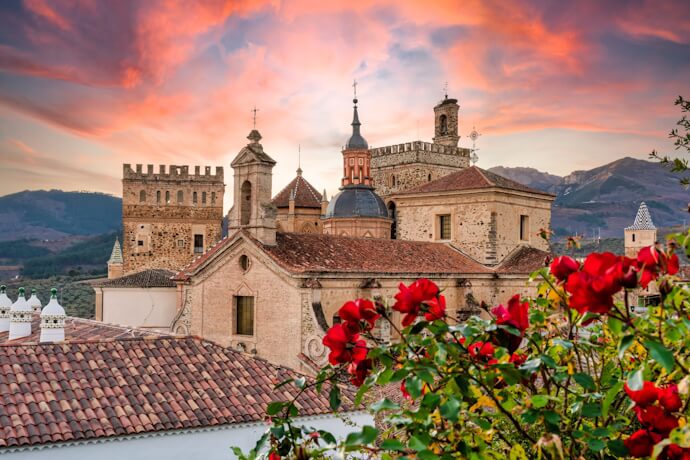
Nestled within the verdant embrace of the Extremadura region, close to the beautiful city of Cáceres, the Royal Monastery of Santa María de Guadalupe is a jewel of Gothic and Mudéjar artistry that has drawn pilgrims, kings, and seekers of beauty for centuries. This UNESCO World Heritage Site, recognized in 1993, is more than just a mere monument!
Architecturally, the Royal Monastery of Santa María de Guadalupe is a masterclass in the blending of styles, where the solemnity of Gothic mingles with the intricate beauty of Mudéjar art, and Renaissance flourishes hint at the awakening of a new era of artistic and intellectual exploration. Its cloisters, chapels, and sacristy are adorned with works of art that span centuries, including stunning frescoes, altarpieces, and sculptures.
Beyond its spiritual significance, the Royal Monastery of Santa María de Guadalupe has played a pivotal role in the cultural and educational life of Spain. It was here that Columbus sought the blessings of the Virgin before his voyages to the New World.
Cathedral, Alcazar & Archivo de Indias, Seville
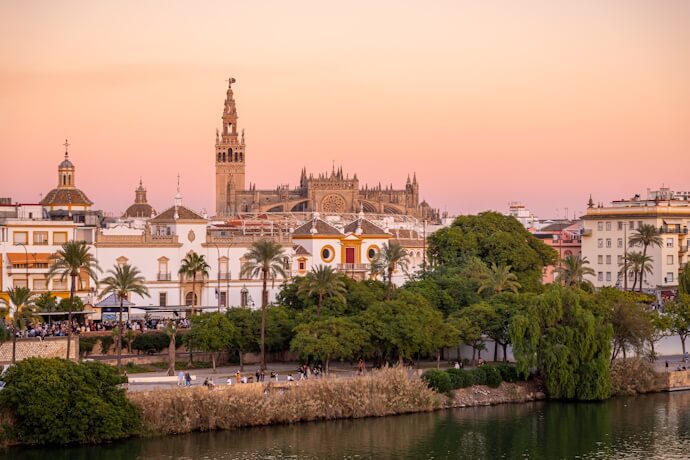
In the heart of Seville, a city that dances to the rhythm of flamenco and is perfumed by orange blossoms, stands a trio of UNESCO World Heritage Sites: the Cathedral, the Alcázar, and the Archivo de Indias. Together, they weave a rich mosaic of architectural grandeur and historical depth.
Seville's Cathedral, is an awe-inspiring testament to Gothic architecture's capacity to lift the human gaze heavenwards. Built on the site of a grand Almohad Mosque in the 1400s, this cathedral is a majestic symphony of stone and light. The Giralda, a minaret turned into a bell tower, stands as a symbol of the layered cultural history of Seville, offering panoramic views that knit together the city's Moorish past and Christian present.
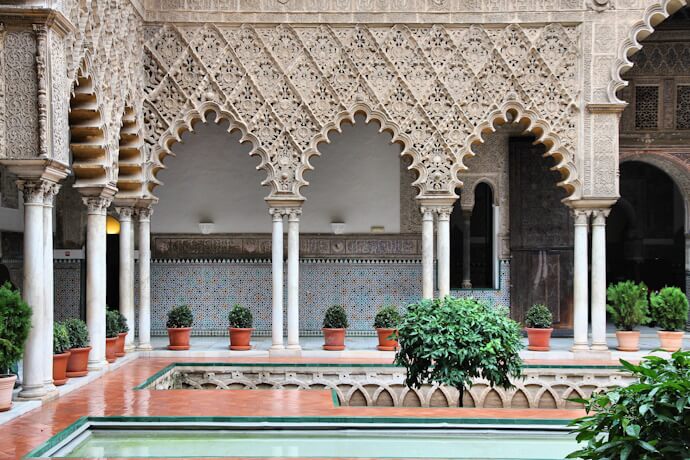
The Alcázar of Seville is a palace of dreams, a fusion of Mudéjar artistry, Renaissance elegance, and Islamic architectural influences that whisper of the caliphs and kings who walked its halls. This royal residence, with its lush gardens, intricate courtyards, and ethereal halls, serves as a living chronicle of Seville’s history.
The Archivo de Indias, housed in the ancient merchants' exchange, is the keeper of the flames of history, a repository of invaluable documents that illuminate the Age of Exploration. Here, the stories of new worlds discovered, of empires expanded and fortunes made, are preserved in millions of pages, offering a window into the complex narratives of colonial expansion.
The soul of Spain: A UNESCO odyssey
From the ethereal beauty of the Alhambra to the surreal forms of Gaudí's creations, from the ancient stones of Segovia's aqueduct to the spiritual serenity of the Royal Monastery of Santa María de Guadalupe, each site offers a window into the diverse narratives that have shaped this nation. Venture on this UNESCO odyssey and be sure to see beyond the country's monuments and landscapes; a realm of shared heritage, history and culture that will make your time in Spain, unforgettable!


